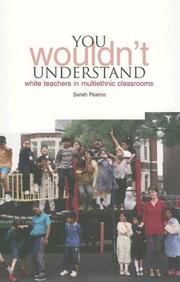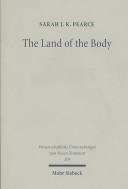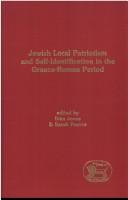| Listing 1 - 10 of 19 | << page >> |
Sort by
|

ISBN: 1858563623 9781858563626 Year: 2005 Publisher: Stoke on Trent : Trentham Books,
Abstract | Keywords | Export | Availability | Bookmark
 Loading...
Loading...Choose an application
- Reference Manager
- EndNote
- RefWorks (Direct export to RefWorks)
Cultural pluralism. --- Discrimination in education --- Multicultural education --- Teaching --- Whites --- Social aspects --- Race identity

ISBN: 9783161492501 3161492501 Year: 2007 Volume: 208 Publisher: Tübingen: Mohr Siebeck,
Abstract | Keywords | Export | Availability | Bookmark
 Loading...
Loading...Choose an application
- Reference Manager
- EndNote
- RefWorks (Direct export to RefWorks)
Jews --- 296*332 --- Philo van Alexandrië:--studies --- 296*332 Philo van Alexandrië:--studies --- Philo, --- Bible. --- Criticism, interpretation, etc. --- History. --- Egypt --- Civilization --- Alexandria, --- Filon --- Filón, --- Filon, --- Filone, --- Philon, --- Philonis, --- Yedidyah, --- פילון --- פילון מאלכסנדריה --- פילון, --- פילון היהודי --- Филон Александрийский --- Filon Aleksandriĭskiĭ --- Pseudo-Philo --- Chumash --- Five Books of Moses --- Ḥamishah ḥumshe Torah --- Ḥumash --- Kitāb-i Muqqadas --- Mose Ogyŏng (Book of the Old Testament) --- Pentateuch --- Pi︠a︡toknizhīe Moiseevo --- Sefer Ḥamishah ḥumshe Torah --- Tawrāh --- Torà (Pentateuch) --- Torah (Pentateuch) --- Tʻoris xutʻcigneuli --- Ureta --- תורה --- Haftarot --- Jews - Egypt.
Book
ISSN: 00222097 ISBN: 9780957522800 0957522800 Year: 2013 Volume: 2 Publisher: Yarnton: Journal of Jewish Studies,
Abstract | Keywords | Export | Availability | Bookmark
 Loading...
Loading...Choose an application
- Reference Manager
- EndNote
- RefWorks (Direct export to RefWorks)
Against the commonly held opinion that ancient Judaism was an artless culture, this sumptuously illustrated book offers new ways of looking at art in Jewish antiquity. Leading experts, under the editorship of Sarah Pearce, skilfully explore different functions of images in relation to their prohibition by the Second of the Ten Commandments. The visual world of ancient Judaism often reflects a tense confrontation between Mediterranean, artful classical culture and the image-filled, yet law-inspired biblical literature. Readers will encounter a rich collection of objects and texts analysed in different contexts, from Solomon’s Temple to late antiquity. The imageless God of monotheistic Judaism combated the polytheistic cults of Israel’s neighbours with the use of symbols. Figurative, floral and geometrical embellishments of synagogues served as decoration and not for worship. Narrative biblical scenes in the Dura-Europos synagogue played an educational and political role in Jewish society on the outskirts of the Roman Empire. Antique Jewish art exercised a profound influence on medieval Islam and even on the modern Western visual world. This book is aimed at both the scholarly world and all readers interested in religion and art.
Jewish art --- God --- Jews --- Civilization --- Classical influences --- 296 --- Judaisme --- Idols and images --- Jewish art. --- History. --- Biblical teaching. --- Jewish art - Pictorial works --- God - Art --- Jews - Civilization - Classical influences
Book
ISBN: 9783161507335 3161507339 Year: 2013 Volume: 152 Publisher: Tübingen: Mohr Siebeck,
Abstract | Keywords | Export | Availability | Bookmark
 Loading...
Loading...Choose an application
- Reference Manager
- EndNote
- RefWorks (Direct export to RefWorks)
222.4 --- Deuteronomium --- Bible. --- Deuteronomium (Book of the Old Testament) --- Deuteronomy (Book of the Old Testament) --- Devarim (Book of the Old Testament) --- Kitāb-i Divārīm (Book of the Old Testament) --- Shinmeiki (Book of the Old Testament) --- Sifr al-Tathniyah (Book of the Old Testament) --- Sinmyŏnggi (Book of the Old Testament) --- Tas̲niyah (Book of the Old Testament) --- Tathniyah (Book of the Old Testament) --- Criticism, interpretation, etc. --- Law --- Mishpat Ivri --- Biblical teaching. --- History

ISBN: 1850758328 Year: 1998 Publisher: Sheffield : Sheffield Academic Press,
Abstract | Keywords | Export | Availability | Bookmark
 Loading...
Loading...Choose an application
- Reference Manager
- EndNote
- RefWorks (Direct export to RefWorks)
933.3 --- 933.51 --- Geschiedenis van het Joodse volk: Tweede Tempelperiode--(538 v.Chr.-70 n.Chr.) --- Geschiedenis van het Joodse volk: Romeinse tijd II--(70-325) --- 933.51 Geschiedenis van het Joodse volk: Romeinse tijd II--(70-325) --- 933.3 Geschiedenis van het Joodse volk: Tweede Tempelperiode--(538 v.Chr.-70 n.Chr.)
Book
ISBN: 9780253026019 0253026016 9780253025968 0253025966 Year: 2017 Publisher: Bloomington, Indiana ; Indianapolis, [Indiana] : Indiana University Press,
Abstract | Keywords | Export | Availability | Bookmark
 Loading...
Loading...Choose an application
- Reference Manager
- EndNote
- RefWorks (Direct export to RefWorks)
"Beginning in 1172, Judah ibn Tibbon, who was called the father of Hebrew translators, wrote a letter to his son that was full of personal and professional guidance. The detailed letter, described as an ethical will, was revised through the years and offered a vivid picture of intellectual life among Andalusi elites exiled in the south of France after 1148. S. J. Pearce sets this letter into broader context and reads it as a document of literary practice and intellectual values. She reveals how ibn Tibbon, as a translator of philosophical and religious texts, explains how his son should make his way in the family business and how to operate, textually, within Arabic literary models even when writing for a non-Arabic audience. While the letter is also full of personal criticism and admonitions, Pearce shows Ibn Tibbon making a powerful argument in favor of the continuation of Arabic as a prestige language for Andalusi Jewish readers and writers, even in exile outside of the Islamic world"--
Wills, Ethical. --- Hebrew literature, Medieval --- Ethical wills --- Jewish ethics --- Arabic influences. --- Tibon, Yehudah ibn,
Article
Abstract | Keywords | Export | Availability | Bookmark
 Loading...
Loading...Choose an application
- Reference Manager
- EndNote
- RefWorks (Direct export to RefWorks)
Book
ISBN: 9789004435391 9004435395 9789004435407 9004435409 Year: 2021 Publisher: Leiden;Boston BRILL
Abstract | Keywords | Export | Availability | Bookmark
 Loading...
Loading...Choose an application
- Reference Manager
- EndNote
- RefWorks (Direct export to RefWorks)
In Israel in Egypt scholars in different fields explore what can be known of the experiences of the many and varied Jewish communities in Egypt, from biblical sources to the medieval world. For generations of Jews from antiquity to the medieval period, the land of Egypt represented both a place of danger to their communal religious identity and also a haven with opportunities for prosperity and growth. A volume of collected essays from scholars in fields ranging from biblical studies and classics to papyrology and archaeology, Israel in Egypt explores what can be known of the experiences of the many and varied Jewish communities in Egypt, from biblical sources to the medieval world.
Jews --- Jewish literature --- 296 <620> --- 291.16 <620> --- 291.16 <620> Verhouding tussen de godsdiensten. Verdraagzaamheid. Interreligieuze dialoog--Egypte --- Verhouding tussen de godsdiensten. Verdraagzaamheid. Interreligieuze dialoog--Egypte --- 296 <620> Judaisme--Egypte --- 296 <620> Judaïsme. Jodendom--Egypte --- Judaisme--Egypte --- Judaïsme. Jodendom--Egypte --- Hebrews --- Israelites --- Jewish people --- Jewry --- Judaic people --- Judaists --- Ethnology --- Religious adherents --- Semites --- Judaism --- History --- History and criticism --- Bible. --- Antico Testamento --- Hebrew Bible --- Hebrew Scriptures --- Kitve-ḳodesh --- Miḳra --- Old Testament --- Palaia Diathēkē --- Pentateuch, Prophets, and Hagiographa --- Sean-Tiomna --- Stary Testament --- Tanakh --- Tawrāt --- Torah, Neviʼim, Ketuvim --- Torah, Neviʼim u-Khetuvim --- Velho Testamento --- Criticism, interpretation, etc.
Book
ISBN: 9004407545 9004369139 Year: 2020 Publisher: Leiden, The Netherlands ; Boston : Brill,
Abstract | Keywords | Export | Availability | Bookmark
 Loading...
Loading...Choose an application
- Reference Manager
- EndNote
- RefWorks (Direct export to RefWorks)
"'His Pen and Ink are a Powerful Mirror' is a volume of collected essays in honor of Ross Brann, written by his students and friends on the occasion of his 70th birthday. The essays engage with a diverse range of Andalusi and Mediterranean literature, art, and history. Each essay begins from the organic hybridity of Andalusi literary and cultural history as its point of departure, introduce new texts, ideas, and objects into the disciplinary conversation or radically reassesses well-known ones, and represent the theoretical, methodological, and material impacts Brann has had and continues to have on the study of the literature and culture of Jews, Christians, and Muslims in al-Andalus. Contributors include: Ali Humayn Akhtar, Esperanza Alfonso, Peter Cole, Jonathan Decter, Elisabeth Hollender, Uriah Kfir, S.J. Pearce, F.E. Peters, Arturo Prats, Cynthia Robinson, Tova Rosen, Aurora Salvatierra, Raymond P. Scheindlin, Jessica Streit, Shawkat M. Toorawa, David Torollo".
Arabic literature --- History and criticism. --- Andalusia (Spain) --- Civilization.
Article
Abstract | Keywords | Export | Availability | Bookmark
 Loading...
Loading...Choose an application
- Reference Manager
- EndNote
- RefWorks (Direct export to RefWorks)
| Listing 1 - 10 of 19 | << page >> |
Sort by
|

 Search
Search Feedback
Feedback About UniCat
About UniCat  Help
Help News
News